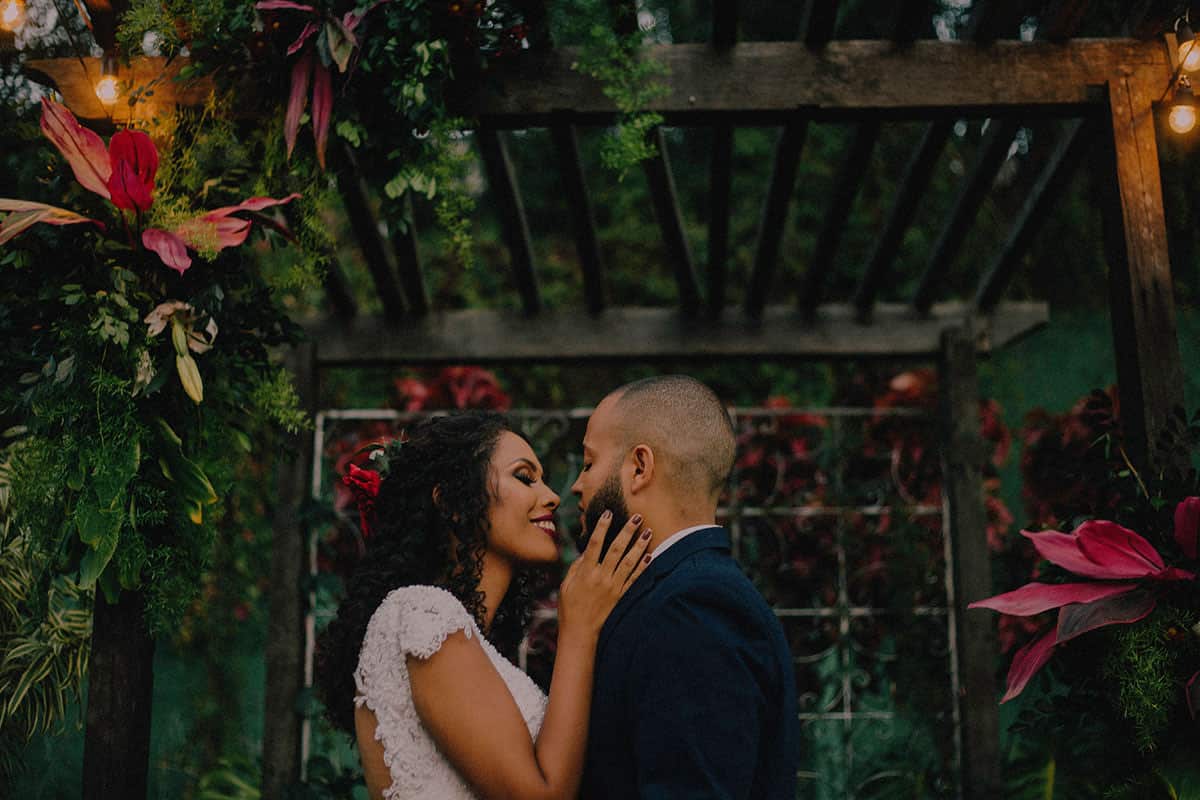You’ve got the best wedding camera, the best wedding lenses, the best accessories. You’ve shot your first few weddings. Now, it’s time show off your work and create a wedding website. When it comes to growing your wedding photography business, an online portfolio is an absolute must-have. Not only will it showcase your style and skill, but maintaining a polished portfolio will demonstrate that you have the professionalism necessary to capture prospective clients’ most important day.
If this sounds overwhelming, fear not! You can create the portfolio of your dreams in just nine easy steps.
1. Assess the Competition
Before you start building your wedding portfolio, it’s essential that you assess the current market and suss out your competition first. Check out a bunch of outstanding wedding portfolios in different styles to give you a better sense of who is killing it. Seeing other wedding website examples will help you figure out where the gaps in the market are.
Make a list of 10 to 15 photographers that you admire and spend some time familiarizing yourself with their wedding photography websites. Make note of the things you think they do well—and, more importantly, the things you think they could improve upon. Once you’ve wrapped up your research on the best wedding websites, you should have a handy guide to reference when it comes time to cultivate your own wedding portfolio and market yourself.
While taking stock of your competitors, consider:
- What platform are they using to showcase their wedding photography portfolio?
- What does their branding look like? What does it say about their company?
- What kind of selects have they decided to showcase on their wedding website?
- How have they organized their portfolio? Is it easy to navigate?
- What does the copy on their website sound like? Are they telling a story?
- Would you want to hire them? Why?
Rather than using this information to clone what your competitors are doing, take this opportunity to read the market and tap into your niche. Do you keep coming across the same style of photography or lookalike portfolios? Think of ways to offer clients something different. You’re more likely to flourish in an industry when you can fill a need that hasn’t been met yet. Not only will you pick up more clients, you might even be able to charge more in exchange for your fresh aesthetic.

2. Check Your Branding
Now that you’ve figured out what you do and don’t like, it’s time to think about out how you want to position your company. Creating a brand identity before you start building your wedding photography portfolio is key. While your body of work is the most important piece of your branding and will play the biggest role in attracting new clients, your visual aesthetic—including logo, color palette, and typography—are a close second.
If you’ve never built a website for your wedding photography business, you might also want to double check that your custom domain name is available. Having that custom URL for your website will help keep your branding consistent across your entire online presence.
Before you jump into logo design, review your brand guidelines, or, if you’re just starting your branding journey, make sure you have these basics down first.
When you start a company—as a wedding photographer or otherwise—it’s important to have a solid grasp on what is it your company’s all about. After all, a successful brand knows who they are and what they’re trying to achieve. To figure out what makes your company tick you’ll need to answer the following questions:
- What is your service?
- Who is your target audience?
- Who are your competitors?
- What is your value proposition?
Once you’ve nailed down the foundation of your brand identity, it’s time to name your company. For photographers and other creatives branding themselves, your own name is an obvious choice! For those starting a partnership or for those who want to think outside the box by creating something from scratch, it’s a good idea to choose a name that is short-ish and easy to spell.
So you’ve got your name—now you need your logo. Your logo is the face of your business. It is the first thing that people notice when they enter your portfolio. Your logo will also act as a visual identifier across social platforms and marketing materials. A good logo will tell potential clients who you are and what you stand for before they even see your body of work or read your wedding website’s About page.
A good way to start the logo process is by searching the web for visuals. Gathering your inspirations into a mood board will allow you to narrow in on a few different themes, which will be crucial in the actual design process. Once you’re satisfied with your curation and have created a strong, cohesive mood board(s), it’s time to make your own unique wedding photography logo.
Not everyone will have the budget to hire a design agency or freelance designer to create their logo, and that’s okay! A unique logo is just a few clicks away with an online logo generator. Some popular options include:
- Makr
- Logojoy
- Canva
- Ucraft
- Hipster Logo Maker
3. Picking the Platform
We’re all strapped for time these days—especially during busy wedding season! Thankfully, it’s now super easy to build an online portfolio using a website builder. Think of these builders as a one-stop shop, where everything you need to build a great wedding website is housed under one roof. Format, for example, has beautifully-curated, pre-made templates that are easy (and affordable) for anyone with an internet connection to use. By simply dragging and dropping content into the your template (more on that in a second), you can have your wedding portfolio up and running in no time.
When the time comes to look for the right platform for your unique wedding website, some things to consider are:
- What kind of themes does the platform offer? Are they in line with your brand’s aesthetic?
- How many people are using the platform? Is the company showing growth?
- Are reputable artists or companies using this platform?
- How much does it cost to use the platform? Is there a free trial period?
- Does the web platform have a solid support team that can answer your questions? (Format, for example, has an around-the-clock support team.)
Finding a platform that lets you try it for free is always a good way to start. That way, you can play around with the features before committing to a subscription.
So—which portfolio style and theme is right for you?

4. Choose Your Dream Theme
All of the best wedding website builders have pre-made themes that will dictate how your portfolio looks. It’s important to understand that when it comes to themes, what you see is essentially what you get. As the term “pre-made” implies, these themes are already coded, so, while you can customize certain elements of the theme (font size, theme colors), you should choose one that fits your brand as closely as possible.
When you’re starting out, it’s best to choose a theme that is simple, clean and easy to use. Some platforms will even have specific themes to help you create a wedding website. You want potential clients to be able to envision themselves within your wedding shots, so minimizing any clutter is key.
Another important thing to consider when choosing a theme is longevity. It’s best to avoid things that are hyper-trendy and might not be relevant in six months. While renovating a website can be good for a brand once in a while, it’s best to pick a theme that will allow your brand to grow with it. When you’re starting out, solidifying your brand and your name is paramount. If your theme changes every week, it will be hard for clients to wrap their head around your brand identity and, in turn, get behind your work.
5. Selects, Selects, Selects
The most overwhelming part of building your own wedding website is also the most important: picking selects. After you’ve successfully grabbed the attention of potential clients with your chic logo and impactful theme, the thing that’s going to secure new business is, ultimately, your photography.
Whether you’re planning on including four or 400 photos in your portfolio, it’s best to start with the process of elimination.
First, collect all of your wedding photos into one folder. Go through the images, one by one, and tag every photo that you like. Don’t hold back at this stage, as you will want to start with a large number of options, slowly narrowing it down until you’ve reached your best work. After going through your selects a handful of times, take a break so you can remove yourself from the process. Come back with fresh eyes and a new perspective, so you can make sure you’ve chosen the true winners.
As you finalize your selects, consider the following:
- Do the selects reflect your brand?
- Is your work inclusive and diverse?
- Do your selects showcase your range?
- Do these selects portray your distinct aesthetic as a photographer?
Once you have your selects, upload them into your wedding website template and start playing with the order in which they’ll be displayed. Enlist the opinions of trusted friends or industry colleagues to ensure you’re conveying what you want with these images.
6. Tell Your Story
Now that you’ve nailed down the visual elements of your portfolio, it’s time to introduce yourself to your clients. You and your story are a key part of your branding, of course! Sharing what you stand for is a great way to appeal to prospective clients. With so many wedding photographers flooding the market, it’s important to not just show your work, but to craft some skillful storytelling for potential customers about who you are and what you’re about.
Weddings are generally an occasion where clients want to work with people who they can see themselves being friends with—someone who they’d actually want to invite into their most intimate celebration. By giving your audience a glimpse into your life, and adding in some sentiment or humor, you’ll be more likely to forge a connection with them and be top of mind for their shooter shortlist.
If you’re having trouble thinking of things to say about yourself, ask around! Your friends and family will be more than happy to provide you with some of your more unique or loveable qualities. There’s lots of things you can include to paint a fuller picture of yourself: other hobbies, travel experience, favourite TV series, or even photos of your own wedding.

7. Should You Include A Blog?
Blogging can be an extremely powerful marketing tool, and help you sell your wedding services. It can help expand your network and position you and your wedding website as industry leaders. It can also boost your SEO (search engine optimization), which will allow your clients to find you more easily. With Format’s blogging feature, for example, you can easily integrate beautifully designed blog posts into your portfolio, sharing client stories, industry-related news, or interviews with other leaders in the wedding space. A word to the wise: if you are going to create a blog on your portfolio, be prepared to update it regularly. There’s nothing worse than an abandoned blog filled with stale content.
8. Get Those Testimonials
While it can be hard to obtain testimonials so early in the game, this will be essential to bringing in new business. Again, with so many wedding photographers out there, you need the stamp of approval from previous clients to show that you’re a dream to work with. Circle back after each wedding—provided it went well!—and ask the couple for a testimonial. If they loved your work, they’ll be happy to provide you with a glowing review. And that, in turn, leads to more happy customers.
9. Be Open About Your Rates
Being upfront with your rates will eliminate some unpleasant situations. For example, say a couple comes across your portfolio and instantly falls in love with your work; they’re set on booking you, but only have pennies put aside for photography. By displaying your rate card right on your wedding website, it will save them the disappointment of reaching out to you only to find out they can’t book you, and it will save you the guilt of being asked to work for less. If you have a sliding scale, make sure you mention that with your rates, as you also don’t want to lose potential business if you are open to negotiations.
Want to learn more about how to market your wedding website? Check these out!
A Guide to Social Media Strategy For Your Creative Business
Four Artists Use Their Websites To Sell Their Work
How To Get 20k Instagram Followers









